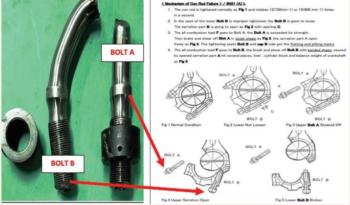The Nautical Institute presents an incident where, the engine crew started auxiliary engine No.1 for a routine operational test while at anchor.
The incident
After about two minutes of warm up the engine was connected to the electrical board.
A few minutes later, there was a loud noise followed by strong vibrations. Numerous alarms were activated, and the engineers immediately disconnected and stopped the affected engine.
A forensic examination of the damaged engine and reconstruction of the sequence of events suggested that one of the two studs of the cam shaft connecting rod for cylinder two had not been adequately tightened during maintenance. A gap developed due to stud B being under-torqued. This overstressed stud A, which consequently sheared and caused the subsequent damage sequence.
Following this hypothesis, the hydraulic stud tensioning pump used for tightening the con rod mechanism was thoroughly examined. The pressure gauge on this pump read 60 bar higher than actual supplied pressure. This could well have led to the less than adequate tensioning of the connecting rod nuts during maintenance, and could be the cause of premature failure. The company subsequently added periodic calibration of the hydraulic stud tensioning pump as a separate item within the PMS.

Lessons learned
- Correct stud/bolt torquing of engine parts is a critical feature of maintenance. Many incidents and accidents have occurred in the past due to incorrect torquing. Having a properly calibrated tensioning pump is vital to attain the required specifications.
- Planned Maintenance Systems (PMS) are a lynchpin of safety – use them rigorously and add value to them when the opportunity presents itself, as in this occurrence.






























































